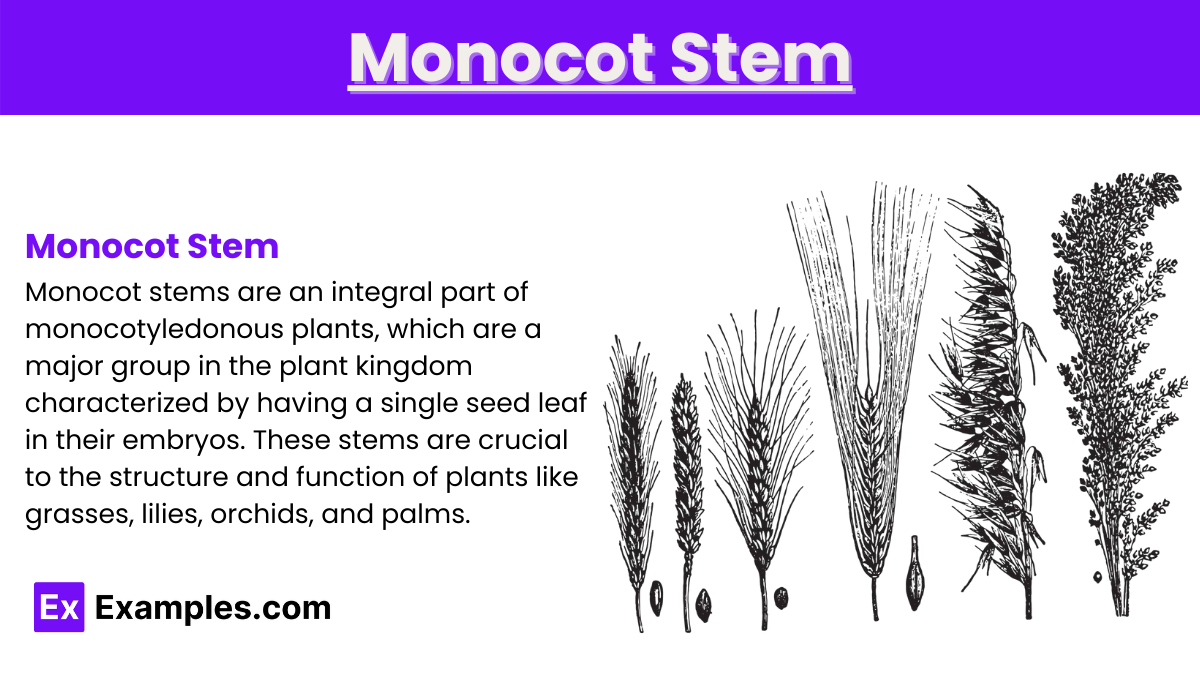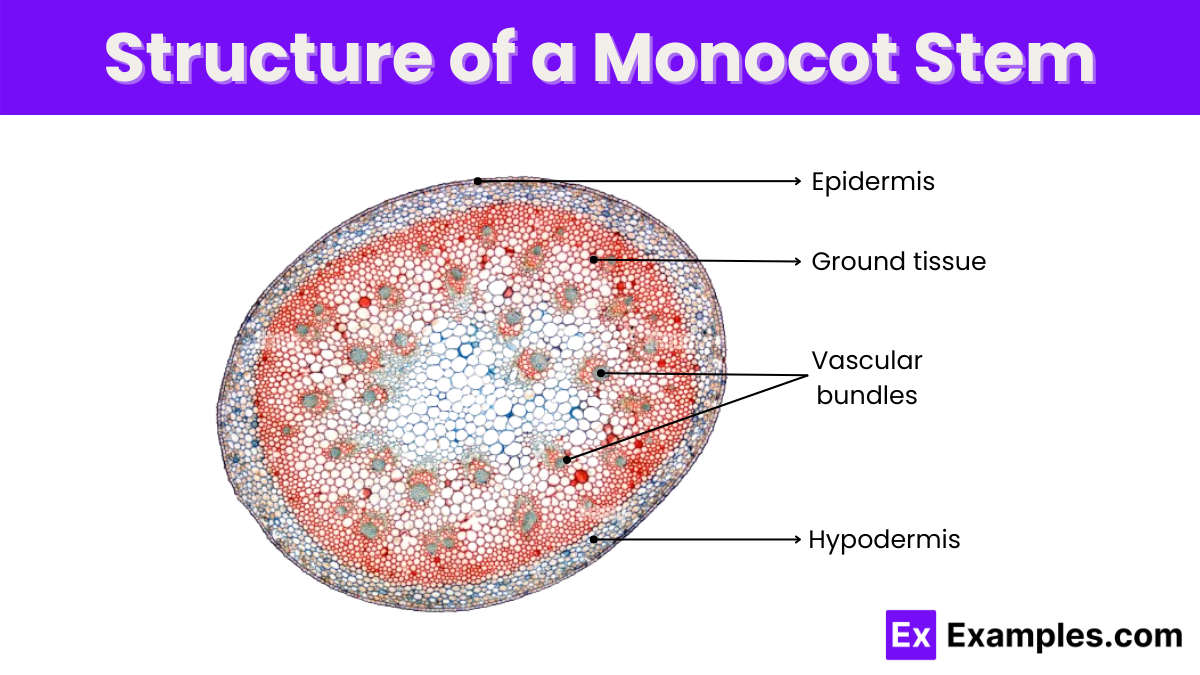What is a distinguishing feature of a monocot stem?
Vascular bundles in a ring
Scattered vascular bundles
Presence of secondary growth
Centralized pith


Monocot stems form the structural backbone of some of the most ecologically and economically important plants, including grains like wheat and rice, and tropical staples such as bananas and palms. Unlike dicot stems, monocot stems showcase a unique arrangement of vascular tissues that supports both the rapid vertical growth and the ability to transport water and nutrients efficiently. This article delves into the anatomy of monocot stems, highlighting their distinctive features and the role they play in plant physiology and survival. We explore the vascular bundle arrangement, the absence of secondary growth, and how these characteristics influence the plant’s overall lifecycle and adaptation strategies in diverse environments.
Monocot stems are an integral part of monocotyledonous plants, which are a major group in the plant kingdom characterized by having a single seed leaf in their embryos. These stems are crucial to the structure and function of plants like grasses, lilies, orchids, and palms. They differ markedly from the stems of dicotyledonous plants (dicots) in several key aspects of their structure and growth.

Monocot stems, characteristic of monocotyledonous plants such as grasses, lilies, and palms, exhibit unique structural features distinct from their dicot counterparts. This structure is adapted to their growth patterns and the environments they typically inhabit. Below is a detailed explanation of the monocot stem structure accompanied by a diagram to aid in visual understanding.
Monocot stems are marked by the presence of scattered vascular bundles throughout the ground tissue, unlike the ringed arrangement seen in dicot stems. This scattering supports the plant’s ability to resist mechanical stress, providing a robust structure suitable for various environmental conditions.
Monocot stems perform several vital functions that contribute to the growth, survival, and reproduction of monocotyledonous plants. These functions are pivotal to the plants’ adaptation to their environments and their role in ecosystems. Here are the key functions of monocot stems:
Monocots, or monocotyledons, are a major group of flowering plants characterized by having one seed leaf, or cotyledon, in their seeds. The stems of monocots are distinct in their structure, often showing scattered vascular bundles and lacking the secondary growth typical in dicotyledonous plants. Below are some common examples of plants with monocot stems, highlighting the diversity within this plant group.
The monocot stem, characteristic of monocotyledon plants, is formed through a series of developmental processes that start from the embryonic stage. Monocots, such as grasses, lilies, and palms, exhibit unique structural features in their stems, which are crucial for their growth and functionality. Here’s a step-by-step look at how the monocot stem forms:
The formation of the monocot stem begins with seed germination. The monocot seed contains an embryo with a single cotyledon, known as the scutellum. Upon germination, the embryo’s plumule, which is the embryonic shoot, emerges and begins to develop into the stem.
Primary growth is driven by the apical meristem located at the tip of the stem. This meristem is a region of actively dividing cells that extend the length of the stem. In monocots, the primary growth is significant as it enables the stem to elongate and push through the soil surface.
As the stem elongates, vascular bundles, which contain xylem and phloem, differentiate within the stem. In monocots, these vascular bundles are scattered throughout the stem’s cross-section. This scattered arrangement contrasts with the ringed pattern seen in dicots and is pivotal for providing structural support and facilitating efficient water and nutrient transport.
Surrounding the vascular bundles is the ground tissue, which comprises mostly of parenchyma cells. These cells are involved in storage and metabolic processes. In monocots, the ground tissue is more homogenous and extensive compared to dicots, filling the spaces between the vascular bundles and contributing to the stem’s rigidity and strength.
The outermost layer of the monocot stem is the epidermis. It forms a protective layer that shields the inner tissues from physical damage and pathogen invasion. The epidermis may also have specialized cells like stomata for gas exchange and trichomes for protection.
Unlike dicot stems, monocot stems generally do not undergo extensive secondary growth due to the absence of a vascular cambium. However, some monocots can exhibit a form of secondary thickening conferred by the activity of a secondary thickening meristem which allows for some increase in girth.
When observed under a microscope, a monocot stem presents several distinctive features:
Monocot stems have scattered vascular bundles, while dicot stems feature a ring-like arrangement of these bundles.
Monocot stems typically lack secondary growth and vascular cambium.
Monocot stems contain scattered vascular bundles, bundle sheath cells, and a large amount of parenchyma for storage.
Yes, monocot stems have a cuticle, which is a waxy protective layer that helps prevent water loss.
A monocot stem is part of a monocotyledonous plant, characterized by scattered vascular bundles and no secondary growth.
Text prompt
Add Tone
10 Examples of Public speaking
20 Examples of Gas lighting
What is a distinguishing feature of a monocot stem?
Vascular bundles in a ring
Scattered vascular bundles
Presence of secondary growth
Centralized pith
Which of the following plants has a monocot stem?
Sunflower
Oak
Corn
Maple
What type of tissue is found at the outermost layer of a monocot stem?
Phloem
Xylem
Pith
Epidermis
Which of the following is NOT a characteristic of monocot stems?
Presence of pith
Scattered vascular bundl
Absence of vascular cambium
Presence of secondary growth
In a monocot stem, the vascular bundles are:
Arranged in a ring
Scattered
Located only in the center
Absent
Which type of growth is typically absent in monocot stems?
Primary growth
Secondary growth
Apical growth
Lateral growth
In monocot stems, the vascular bundles are surrounded by:
Cortex
Pith
Ground tissue
Endodermis
What type of cells are found in the vascular bundles of monocot stems?
Only xylem cells
Only phloem cells
Both xylem and phloem cells
Only sclerenchyma cells
The ground tissue in a monocot stem primarily consists of:
Parenchyma cells
Sclerenchyma cells
Collenchyma cells
Tracheids
How are the vascular bundles arranged in a monocot stem?
In concentric circles
In radial lines
Randomly scattered
In parallel rows
Before you leave, take our quick quiz to enhance your learning!

